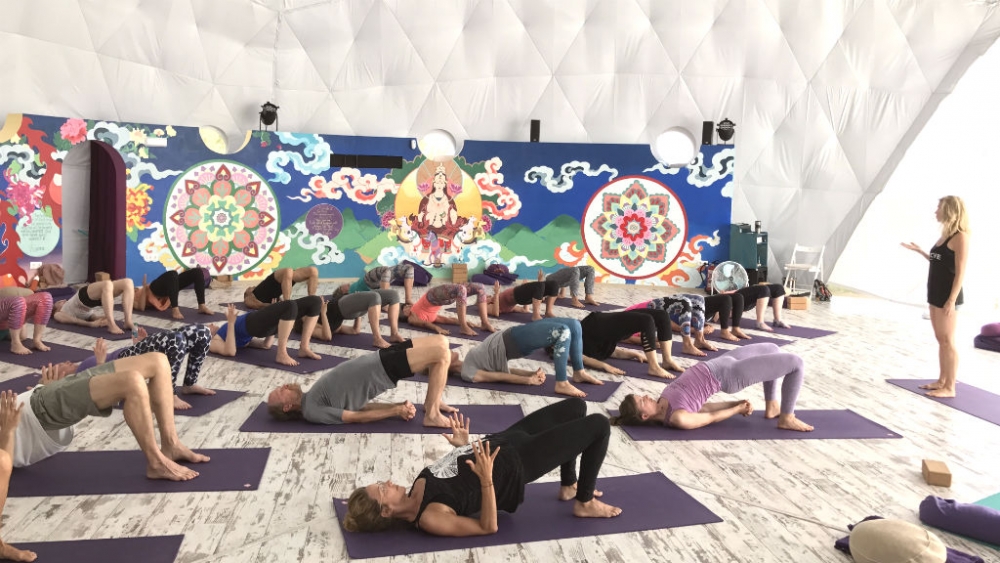Everyone who has ever been on one of my yoga teacher trainings will probably have run into some old, unresolved and painful emotions at some point. In fact, most teacher training courses (especially the intensives) will tell you beforehand that this is likely to happen.
My take on it is that a yoga teacher training course should be designed to help you meet your deepest emotions. That it is even something to look forward to! Why? Because traditionally yoga is a path to wake up to your true Self. The only way you are ever going to evolve on that path is by pausing… feeling… being… and meeting those parts of yourself that you have been suppressing, so that you can become whole again.
Holding the space
Encouraging your trainees to sit and hold the space for their own pain (so that eventually they will be able to do that for their own students) is one of the biggest gifts you can give your teacher trainees. And it is one of the biggest gifts you can receive as a student. You will become a wise, compassionate sought-after teacher, because yoga students will feel this intuitively and seek you out.
When you can sit with your own pain and emotional issues, without being afraid or holding back, and you have seen and understood your own deeper mind, you are no longer afraid or uncomfortable to sit with someone else who is trying to do the same. In my opinion, this is a quality that for a teacher, is just as important as learning about anatomy to prevent physical injuries.
I feel strongly that any yoga teacher interested in helping people to become stronger, more relaxed and free, as well as to help advance them on their spiritual path, should embody this quality of being able to be with themselves and others in pain. To watch and witness without judgment and with compassion.
Don’t try to ‘fix’ anything
As a teacher trainee you need to be open to looking at your own unresolved issues, feeling the pain without trying to ‘fix’ anything. Simply being with the pure raw emotions and the physical sensations that you experience in your body, without getting caught up in the stories.
The stories can get complicated and messy and re-traumatize you. But you can learn to stay present in the moment, with your breath, while sitting with the physical feelings, giving them space and being compassionate towards what it is you are experiencing. Eventually you will integrate these feelings and deal with them constructively. This will be a huge relief, and it will make you feel whole again. Then, you have something real to give to your students!
Building trust
Don’t be mistaken – your students will sense whether you are capable of sitting with your own pain and thus theirs. When students intuitively feel you can’t be that person for them they most likely won’t go down that path, they’ll feel unsafe with you. This way students will be missing out on a lot.
The intuitive ‘knowing’ that they are with someone who can provide that space for them to slowly unwind and allow their vulnerability to arise when it’s their time to let go of old stuff, will help them slowly integrate all their different, repressed parts. When they start to feel whole again they’ll tap into an effortless happiness that has always been there (it was just covered up). Isn’t that what we all want?
Make your class a safe space

So, the most important work for you as a yoga teacher is to transform the class you teach into a “safe place”. A safe place for your students to explore their body, mind and emotions. I believe that the underlying energy and message in a yoga class should be that everything is allowed to be there. Of course, you can say that as a teacher, but if you don’t know what that really means (i.e. you haven’t done the work yourself), the words are empty and meaningless and your students will feel that on a deeper level.
Please note, there is a significant difference between holding the space for someone, or a group of people, and the need to solve people’s problems. That is something you shouldn’t need to do – and moreover may not be qualified to do.
Please note, there is a significant difference between holding the space for someone, or a group of people, and the need to solve people’s problems.
I believe it’s actually much more powerful to just listen, be there and hold that space, perhaps asking some open questions so students can have their own insights and find their own solutions when and if it’s their time. But when your aim as a teacher is to try and fix things instead of just being with them, in essence what you’re saying is: “make it go away please”, which is exactly the opposite of the message that it’s ok to feel as you feel.
Face up to feeling

Of course, you may meet the occasional student that needs more help. In this case, it’s helpful to know a specialist beforehand that you trust and can refer them to, if necessary. The same goes for physical issues of course.
One of the most important things I’ve learned is to stop being afraid of feeling. Start being curious and interested in your emotional life. Not the stories that you attach to it, but the pure, raw emotions and the physical sensations that belong to it.
By looking openly and honestly at your own emotional issues and learning to hold the space for others to do the same means you’ll be better equipped to begin the journey of becoming a heartfelt, wise, authentic yoga teacher for your future students.
With love,
Esther
Related:
- To train with Esther, visit our Workshops page
- Read: 10 things to know before yoga teacher training

